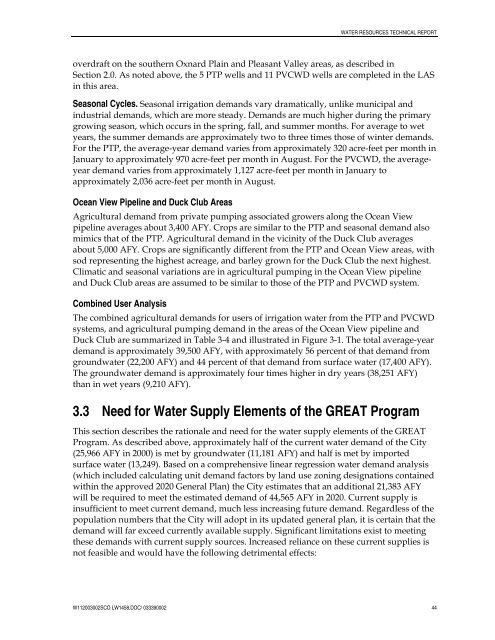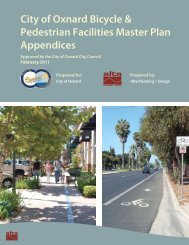View File - Development Services - City of Oxnard
View File - Development Services - City of Oxnard
View File - Development Services - City of Oxnard
Create successful ePaper yourself
Turn your PDF publications into a flip-book with our unique Google optimized e-Paper software.
WATER RESOURCES TECHNICAL REPORToverdraft on the southern <strong>Oxnard</strong> Plain and Pleasant Valley areas, as described inSection 2.0. As noted above, the 5 PTP wells and 11 PVCWD wells are completed in the LASin this area.Seasonal Cycles. Seasonal irrigation demands vary dramatically, unlike municipal andindustrial demands, which are more steady. Demands are much higher during the primarygrowing season, which occurs in the spring, fall, and summer months. For average to wetyears, the summer demands are approximately two to three times those <strong>of</strong> winter demands.For the PTP, the average-year demand varies from approximately 320 acre-feet per month inJanuary to approximately 970 acre-feet per month in August. For the PVCWD, the averageyeardemand varies from approximately 1,127 acre-feet per month in January toapproximately 2,036 acre-feet per month in August.Ocean <strong>View</strong> Pipeline and Duck Club AreasAgricultural demand from private pumping associated growers along the Ocean <strong>View</strong>pipeline averages about 3,400 AFY. Crops are similar to the PTP and seasonal demand alsomimics that <strong>of</strong> the PTP. Agricultural demand in the vicinity <strong>of</strong> the Duck Club averagesabout 5,000 AFY. Crops are significantly different from the PTP and Ocean <strong>View</strong> areas, withsod representing the highest acreage, and barley grown for the Duck Club the next highest.Climatic and seasonal variations are in agricultural pumping in the Ocean <strong>View</strong> pipelineand Duck Club areas are assumed to be similar to those <strong>of</strong> the PTP and PVCWD system.Combined User AnalysisThe combined agricultural demands for users <strong>of</strong> irrigation water from the PTP and PVCWDsystems, and agricultural pumping demand in the areas <strong>of</strong> the Ocean <strong>View</strong> pipeline andDuck Club are summarized in Table 3-4 and illustrated in Figure 3-1. The total average-yeardemand is approximately 39,500 AFY, with approximately 56 percent <strong>of</strong> that demand fromgroundwater (22,200 AFY) and 44 percent <strong>of</strong> that demand from surface water (17,400 AFY).The groundwater demand is approximately four times higher in dry years (38,251 AFY)than in wet years (9,210 AFY).3.3 Need for Water Supply Elements <strong>of</strong> the GREAT ProgramThis section describes the rationale and need for the water supply elements <strong>of</strong> the GREATProgram. As described above, approximately half <strong>of</strong> the current water demand <strong>of</strong> the <strong>City</strong>(25,966 AFY in 2000) is met by groundwater (11,181 AFY) and half is met by importedsurface water (13,249). Based on a comprehensive linear regression water demand analysis(which included calculating unit demand factors by land use zoning designations containedwithin the approved 2020 General Plan) the <strong>City</strong> estimates that an additional 21,383 AFYwill be required to meet the estimated demand <strong>of</strong> 44,565 AFY in 2020. Current supply isinsufficient to meet current demand, much less increasing future demand. Regardless <strong>of</strong> thepopulation numbers that the <strong>City</strong> will adopt in its updated general plan, it is certain that thedemand will far exceed currently available supply. Significant limitations exist to meetingthese demands with current supply sources. Increased reliance on these current supplies isnot feasible and would have the following detrimental effects:W112003002SCO LW1458.DOC/ 033390002 44
















